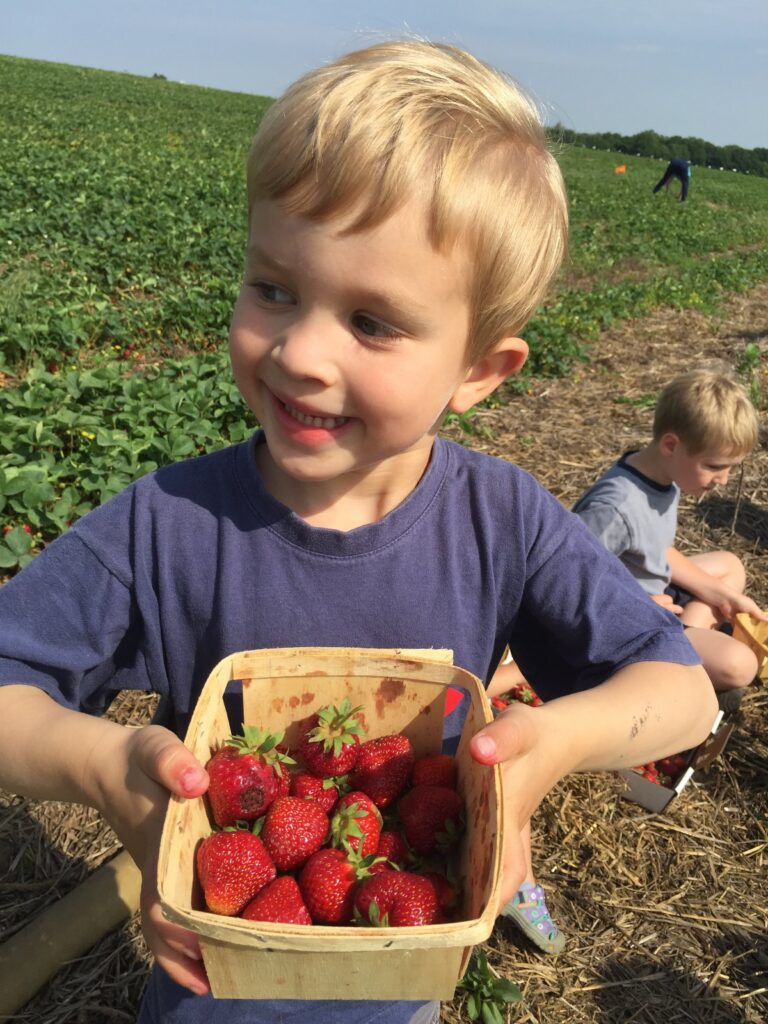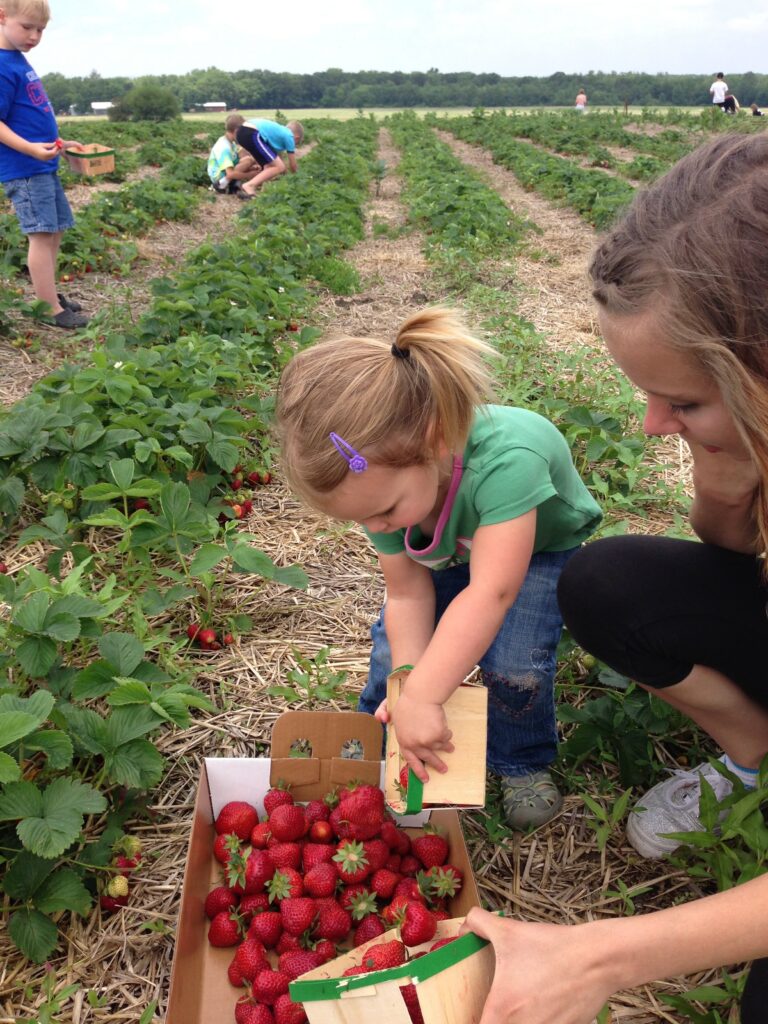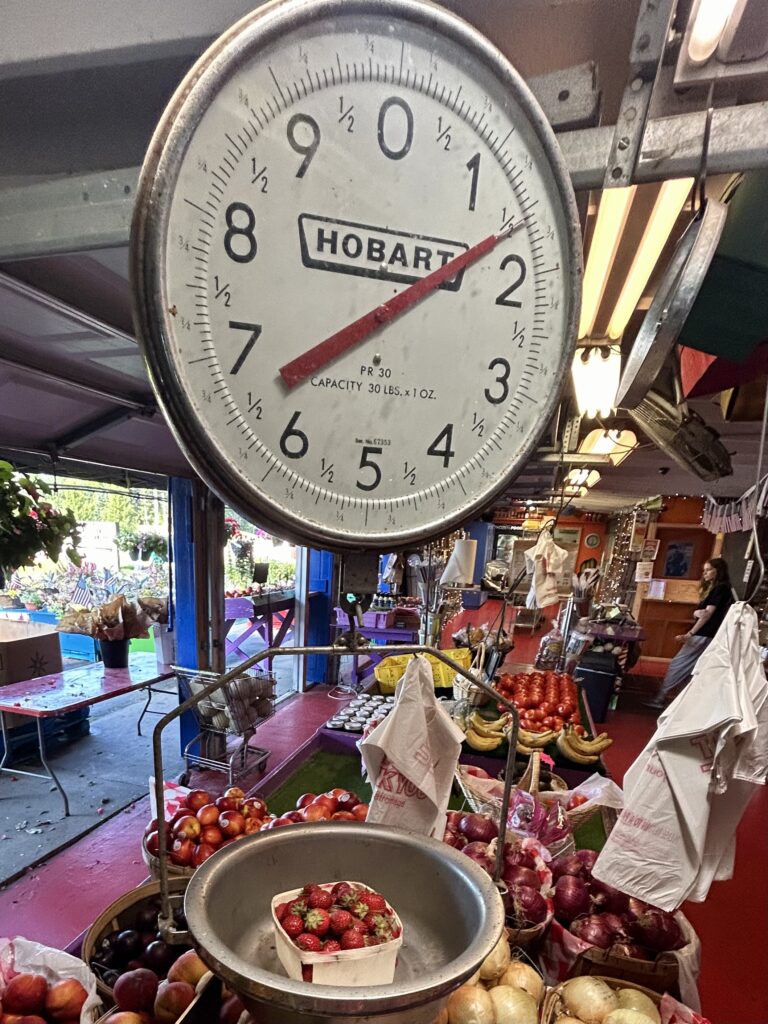Finding Math in a Field of Strawberries

“I’ll carry the biggest container,” volunteers four-year-old Matthew as the younger children fall in behind him.
Picking strawberries during the first week of summer break is an annual tradition in our early childhood program. What better way to learn about counting, measuring and estimating than to get out in the fresh air and sunshine and enjoy hands-on activities that engage all of the senses—from seeing and hearing to touching, tasting and smelling?
I am fairly certain that we are eating as many strawberries as we pick! But that makes this math-packed adventure even better because children learn best through their senses.

The friendly folks at our local U-pick farm assign us a numbered row to pick from, which gives us yet another way to factor math into our strawberry-picking adventure: number recognition!
“We are in Row 66 today,” I call out to the children as they march behind me, wearing their strawberry boxes as hats.
As we walk past each row, Matthew begins to count, “1 . . . 2 . . . 3 . . .”
“I can do it!” blurts out three-year-old Owen. He races to the front of the line, positions himself at Matthew’s side, and picks up where his older friend left off: “4 . . . 5 . . . 6 . . .”
Matthew gently takes over the counting when Owen reaches the limits of his number knowledge at the 13th row. But as Matthew counts out the double-digit numbers, I can hear Owen echoing him, which is a great way for Owen and his younger peers to practice their counting skills.
“Row 66!” Owen stops abruptly and swivels his head from left to right as he surveys the row dotted with bright red strawberries just waiting to be picked. “There must be millions,” he observes in awe.
Maybe not millions, but this is a great opportunity to introduce concepts such as quantity and estimating. In fact, one of the best places to strengthen math skills is in the garden.
“Kindergarten” is a German word that literally means “children’s garden,” which covers Froebel’s concept of “a place for children,” as well as his beliefs regarding childhood growth, development and learning (Elkind, 2015).
Teaching math in a garden comes naturally as children count, sort, find patterns, and organize by size, color or other attributes.
“Look at how big this strawberry is!” Owen exclaims excitedly. “I bet it’s the biggest one we find all day!”
What starts out as a competition to find the largest strawberry is soon replaced by relaxed camaraderie as the children bite into the sun-warmed fruit and the juice stains their lips, chins and fingers bright red.

“Close your eyes and open your hands,” Asa tells Harper as she plops a strawberry into each of Harper’s outstretched palms. “Now tell me which strawberry weighs more.”
Harper obliges. “Definitely this one!” he answers, holding up his left palm and opening his eyes. “But that’s weird because the heavier strawberry is smaller . . .”
“I know! I thought that was weird, too!” Asa replies.
Hands-on activities with everyday objects help children learn about measurement. Moments like these also offer real-world opportunities for them to discuss math concepts such as size, weight and capacity.
Children need to talk about mathematical concepts and share their theories with one another and their teachers.
“I wonder which basket will weigh more?” I ask Joseph. “Your basket with eight big strawberries or Vera’s basket with 14 little strawberries?”
“Vera’s! She has 14!” shouts Joseph. We decide to weigh them after we’re done picking to see if his guess is correct.

“I found a double strawberry; I bet it weighs the most!” announces Gabriel with a mischievous grin.
“That’s not FAIR!” the gang whines in unison.
Gabriel laughs. “It’s really cool. I’m taking this one home to show my mom and dad, so please don’t eat it!”
We finish filling our baskets and make our way to the checkout to see how many pounds we’ve picked this year. The sun is getting warmer and our legs are getting weaker. It’s time to rehydrate with some cold water and refuel with a protein-packed lunch.
We’ve picked 13.2 pounds of strawberries! The eight big strawberries in Joseph’s basket did weigh more than the 14 small strawberries in Vera’s basket—but only by two ounces.
No one seems to care. The sun and the heat have sapped us of the energy and enthusiasm we need to discuss size and weight at greater length, but there will be other chances when we return to the classroom.
Although some of these concepts may be a bit too advanced for some of the younger learners in the group, we have planted the seeds for future academic success during a day of fun in the strawberry fields.

Later, back in the classroom, we set up a farmer’s market and invite the parents to purchase baskets of strawberries from their children, who serve as cashiers.
In the days ahead, there will be lots of strawberry snacks, jam-making and strawberry smoothies—along with more opportunities to learn and share early math concepts.
Sink your teeth into some juicy math this summer. Whether you make it to your local farm, the farmer’s market in your community, or simply introduce fruits and vegetables into your early learning program, there’s plenty of math packed into that yummy summer produce!
This was a super fun way to incorporate teaching in a fun way for kids! I think this would also be cool in a classroom setting, creating our own gardens incorporating a creative side to it!
I work with infants and young toddlers.
Yummy idea. Loved the follow up about selling using the scale and teaching money concepts.
This is a great way for teaching to the entre staff.
Looks like a lot of fun and hands on learning!
excellent idea. having different shapes and size of strawberries or fruits to go fetch in a room or outside activities and having the children describe what they observe.
I think the toddlers in my classroom would love this. They may not be ready for the measuring and weighing but the older toddlers could recognize the size differences,
This is a great way to learn measurements. Weight, size, temperature outside
So many math aspects at play. I loved how all the children seemed to be engaged in the activity and having so much fun with math!
Excellent way to have children problem solve and to learn weight, size and discover how strawberry’s grow.
Children were learning away to use strawberries in
multiple math sense ways.
Love this idea. It is a great way to teach children counting, weighting, size, shape differences and just a fun outdoor experience.
This is a great concept to use with students on a field trip and in the school garden we have been planning.
It sounds like a fun and tasty time.
Many great teaching opportunities with this activity! My kids would love it and eating the strawberries too!
I love real-life lessons, it’s always fun bringing children out into nature for a learning experience.